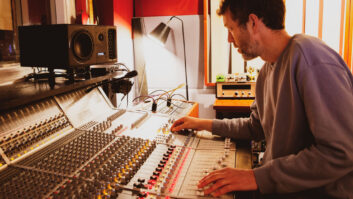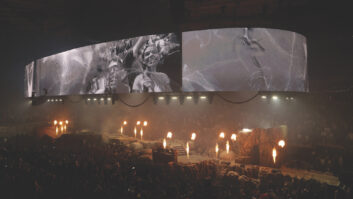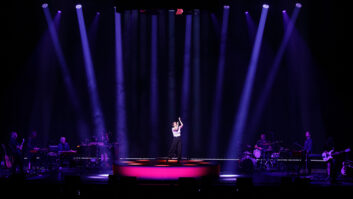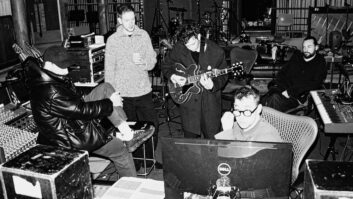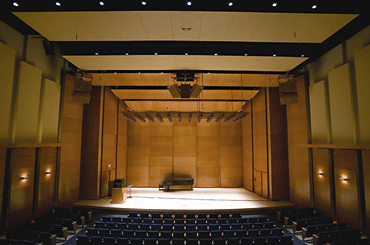

“When Symphony Hall in Boston opened in 1900,” says Tony Hoover, an acoustician and principal with the firm Cavanaugh Tocci, “it got terrible reviews. The conductors at the time, even though many of them had never seen it, just couldn’t believe that a hall designed using engineering principles could sound good. Thankfully, the audiences eventually caught on, and now it’s considered among the three finest-sounding halls in the world.” This is the reason why Hoover, who has some 1,600 projects on his resume, used Symphony Hall as a reference point when he designed Tufts University’s new Distler Recital Hall.
Photos: Joanie Tobin/Tufts University Photo
Distler is just one part — albeit a major one — of the $28 million Granoff Music Center at Tufts, which opened in January of this year. It’s the first building that the school’s music department has ever been able to call its own, and it’s a huge leap forward. There are five state-of-the-art classrooms with computer-controlled audio/visual systems, double-wall-insulated practice rooms where the loudest groups can play without disturbing others, a large rehearsal space that doubles as a second performance venue and a multimedia lab with 13 music/recording workstations — all linked with audio, video and Ethernet.
SOUND DESIGN
Symphony Hall’s architects — McKim, Mead and White — were among the very first to enlist the aid of an acoustics specialist, in their case a young Harvard physics professor named Wallace Sabine. Sabine is the inventor of the concept of RT60 and the standard unit of sound absorption, the sabin, is named after him. Similarly, when tasked with designing Tufts’ new building, architectural firm Perkins & Will called on Tocci to handle the sonic aspects.
Seating only 300 and designed for recitals and chamber music, Distler is hardly on the scale of Symphony Hall, but its stage is large enough for a good-sized orchestra, a big band or an 80-voice choir. And having attended some four-dozen events there, I can attest that its sound is glorious. The reverb seems to last forever (actually, the RT60 is almost exactly two seconds), and it’s remarkably even, anywhere in the hall. There are no slaps or flutter echoes, yet even with all the richness, the sound is crystal-clear — although I’ve noticed it’s sometimes hard to understand conversation-level speech from more than a few feet away.
“What was old is becoming new again,” says Hoover, explaining the design philosophy behind the hall. “We used very significant upper-volume. The hall is four stories high and the seats only go halfway up. It’s the same in Symphony Hall: There are two balconies, but the whole upper-half is open for blooming of reverb. It makes for a much more lush reverberation — not just a longer time, but a smoother sound.
“And while you’re up there, you want to make that volume very diffusive,” Hoover continues. “At Symphony, there are nine different-sized coffers [sunken panels] in the ceiling, and there are niches above the balconies, which break up the sound. In Distler, we used convex shapes that wrap around the hall, all the way up to the ceiling. There are curved overhead reflectors above the stage and angled panels over the audience area.”
There are no absorptive materials on the walls at all. “I went out on a limb with that decision,” says Hoover. “It’s almost a given that you put sound absorption on the rear wall to prevent echoes and anomalies, but I decided to rely entirely on the seating for that.” Eight rows of seats are on the floor, raked gradually, and then there are five more rows that rise sharply to where they meet the rear wall about halfway up. The seats are upholstered. “Acousticians love upholstered seats,” he notes. “Not only are they comfortable, but they are great absorbers and then the sound doesn’t change as much when you have a full audience. The rear wall is diffusive and bumpy, just like the sides.”
Another idea borrowed from Symphony is that there is no proscenium. “A proscenium de-couples the stage house and the audience house,” Hoover explains, “and that arch cuts down on the sound going into the audience more dramatically than you would ever think. This way, the performers and the audience are in the same room.
“The side walls of the stage are angled 10 degrees, and with the reflectors above the stage, the effect is that of a band shell. Now a band shell has three purposes: to assist the propagation of the sound to the audience, to promote blending of the sound and to propagate sound from one side of the stage to the other for cueing” — in other words, making sure the performers can hear each other. For the musicians at Tufts, who are used to playing in low-ceilinged parlors, acoustically dead lecture halls and boomy chapels where hearing the other instruments, or even themselves, has been a major issue — just this aspect of the new hall is cause to jump for joy.
Speaking of jumping, the stage floor is floated on resilient mounts. “It’s mostly to loosen it up a little so the basses and cellos and low end of the piano can get more resonance,” says Hoover. “But it also means that if someone wants to have a concert with a dance component, the stage will work for the dancers.”
One of Hoover’s basic philosophies is that halls designed for Western classical music need to be rectangular, which Distler is. “The starting point is the culture that the music comes out of,” he explains. “Cultures that are more outdoors-oriented tend to have music that’s more rhythmic and percussive because that lends itself to outdoor performance. Cultures more oriented toward being indoors use more melody and harmony and counterpoint. The music follows the acoustic. Organ music is designed for churches. As for chamber music — well, why do you think they call it that?

“There are many reasons why rectangular rooms work so well, as opposed to fan-shaped rooms, none of which I’ve ever been satisfied with. It has to do with the lateral reflections and the accumulations of reflections that build up to make the reverb. It’s more even in a rectangular space. It sounds more ‘real,’ no matter where you sit. Obviously, the relationship between the direct and reflected sound is going to change depending on whether you’re sitting close to the stage or against a side wall or the back wall, but the sense of space doesn’t change. The most important rule is that the length, width and height are all different by a significant amount, at least several feet. And it’s best to have the stage against a narrow wall.”
DON’T FORGET ISOLATION
In addition to the shape, the other critical criteria for a successful concert hall are sound isolation and low ambient noise. Especially in an academic music building, where several concerts, rehearsals and high-SPL classes may be going on at once, isolating the concert hall from exterior sounds is crucial. Distler achieves this by being a box within a box. The side walls have two layers of 8-inch-thick concrete blocks separated by a 2-inch air space. The ceiling is made up of several layers of drywall hung on springs from the building’s roof. The floor is on grade or above unoccupied space, so direct transmission through the floor isn’t an issue, but structure-borne sound might still get in. “There’s a lovely atrium right outside the hall, and what if a jazz combo was playing in there?” asks Hoover. To deal with that, the side walls are stepped where they go under the floor, with four or five small steps that go down about two feet. “With each bend or fold in the floor,” Hoover explains, “you lose about 3 to 4 dB of transmission.”
As for ambient noise, the primary goal was making the ventilation system as quiet as possible. “The HVAC mechanical equipment is not on top of the space, the way you often see it,” notes Hoover, “but it’s adjacent to it, outside of the two rows of concrete. To make sure the air velocities are very slow, we used large ducts, but that meant poking big holes through the wall, which might have hurt the isolation. So we used a ‘housed’ system: a double duct with one inside the other. I can’t hear it operating, even when I stand in the hall and ask them to turn the system on and off. We haven’t had the opportunity to formally measure the ambient level in the hall, but I’m confident that it will be below the noise floor of the instrumentation — and we’ve got some really good instrumentation.”
THE MULTIPURPOSE FACILITY
The university mandated that Distler be usable as both a lecture hall and concert space, requiring sound reinforcement and visual-projection systems. Designed by Cavanugh Tocci A/V systems specialist Matt Moore, the sound system has three ceiling-hung EAW clusters, two side clusters and a subwoofer — all QSC-powered. A Lectrosonics automated mixer and Shure mic mixer handle small P.A. chores, with source-switching via Crestron touchscreen panels at the lectern, stage manager’s post or tech booth. For more complex reinforcement, a Soundcraft GB4-24 console can be used in the booth or the house, along with several EAW wedges for stage monitoring or sidefills and some small EAW boxes for front-fill.
And what about recording? “The most important things for recording are sound isolation and background noise,” says Hoover. “If you’re doing any distant miking, you have to have those. The surfaces come third. Adding stuff onto the walls will not achieve isolation or quiet. You’d be amazed at how many clients don’t realize this. They read the articles and the ads, and put fuzzy stuff all over the walls, but because they have loud ventilation sound and no isolation, it’s not going to help. It goes back to the same fundamentals: Maintain the sound integrity first, then worry about the finishes.”
When the Tufts building committee saw Distler’s potential for recordings, they asked Moore for a spec. His system design covered a wide range of situations, yet had to be geared toward live recording as opposed to studio-style overdubs.
It starts with eight small-capsule AKG mics hung permanently from the ceiling on monofilament lines; servo motors allow these to be moved vertically and horizontally. In the corners are four omnis, and above the first and the sixth rows of the audience are matched pairs of C451B cardioids on stereo mounts. For close-miking, the school has a collection of Neumann, AKG, RØDE, Shure and Audio-Technica models.
The recording mics are fed through a Yamaha DM1000 mixer into a 16-input Pro Tools HD system, as well as a second Pro Tools system (Digi 003/Pro Tools LE) and a Tascam CD recorder. Near-fields include five Event TR6s and a Tannoy TS10 sub. Yet another Pro Tools rig lives on a portable cart, with a Yamaha 01V96 mixer, an Apple MacBook Pro and an Mbox 2 Pro interface. This can be used anywhere in the building, especially the downstairs Fisher rehearsal/performance space, which has tielines to Distler’s tech booth.
Video gear includes a fixed Sony EVID-70 camera with remote pan/tilt/zoom (controlled from the touchscreen panels), a Sony DVD recorder, three Sony DVCAM decks and two Canon Elura 100 cameras that can be used either free-running or with their outputs piped to the tech booth, and blackburst is available for high-end multicamera shoots.
How does Distler sound for recordings? It’s unbelievable. While Hoover and his colleagues didn’t set out to make a great recording space, that’s exactly what they’ve done. The facility’s new, hand-selected 9-foot Steinway concert grand doesn’t hurt, either. So far, we’ve recorded piano soloists and duets, gospel and chamber choruses, jazz combos, string quartets, antiphonal brass choirs, African drum ensembles, and a whole evening of a cappella singing. We’re still experimenting, but our initial recordings have everyone very excited about both the hall’s potential and the flexibility we have just by trying different mic placements and balance.
In case you noticed the subtle “we” shifting of pronouns in the last paragraph, that was no accident: It’s my way of telling you that this wonderful new building is where I now work. I’ve been teaching courses at Tufts since 2000 and was a consultant on the new building. However, when it opened this year, they created a new full-time coordinator of music technology position to oversee all of this stuff, and I’m it. I’m in charge of running the recording and SR systems, as well as the computer and A/V systems in the classrooms, and teaching their operation and maintenance to other faculty and students. And I’m still teaching my classes.
It’s an exciting and incredibly hectic time. As with any new facility, there were plenty of kinks to work out, along with some 55 events that needed tech support in the first 14 weeks, so I’ve been working a lot of long hours. That’s not unusual for me, but what is unusual is that I have to go out of my house to do it. This is the first full-time job I’ve had that requires my physical presence (as opposed to things like product support or Web design that I can do at home) since 1979. It’s a big change.
And it means that I have to make sacrifices in other parts of my life. One of those sacrifices will be yours, dear readers: After this issue, you won’t see me in these pages every month. In an effort to keep what’s left of my sanity, I’m going to be writing “Insider Audio” in alternate months.
Meanwhile, if you are in the Boston area and want to come by and see what Hoover and Moore and the rest of the very talented team that built this place have wrought, feel free to get in touch with me at [email protected]. I’ll be glad to show off the building, the hall and all the new toys. Let me just find my keys.
Paul Lehrman is a composer, producer, writer and filmmaker, but at the moment doesn’t have time to be any of these. His “Insider Audio” columns from the past 10 years have been collected in The Insider Audio Bathroom Reader, available from
mixbooks.com.

READ: Get additional information on the Granoff Music Center at www.tufts.edu/musiccenter/about/overview.html.
